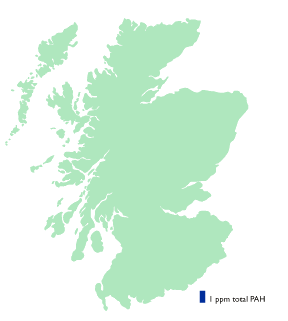PAHs
 Hydrocarbons are a widespread group of chemicals composed of hydrogen and carbon and fall into two classes, the aliphatic and the aromatic hydrocarbons. The hydrocarbons of low molecular weight are relatively easy to degrade in, or volatilize from soils, whereas those with higher molecular weights are often solids and can be resistant to decomposition. The distinguishing feature of aromatic hydrocarbons is the presence of one or more benzene rings. Polycyclicaromatic hydrocarbons (PAHs) are molecules that consist of two or more fused benzene rings and in addition to occurring naturally in coal and crude oil, they are often associated with the products of combustion of fossil fuels. Some PAHs can be powerful carcinogens and are resistant to decay. The lighter molecular weight PAHs can be re-volatilized and re-deposited so that the soil can be a source of such compounds as well as a sink.
Hydrocarbons are a widespread group of chemicals composed of hydrogen and carbon and fall into two classes, the aliphatic and the aromatic hydrocarbons. The hydrocarbons of low molecular weight are relatively easy to degrade in, or volatilize from soils, whereas those with higher molecular weights are often solids and can be resistant to decomposition. The distinguishing feature of aromatic hydrocarbons is the presence of one or more benzene rings. Polycyclicaromatic hydrocarbons (PAHs) are molecules that consist of two or more fused benzene rings and in addition to occurring naturally in coal and crude oil, they are often associated with the products of combustion of fossil fuels. Some PAHs can be powerful carcinogens and are resistant to decay. The lighter molecular weight PAHs can be re-volatilized and re-deposited so that the soil can be a source of such compounds as well as a sink.
Similarly to many of the other pollutants, PAH concentrations, in parts per million (ppm=ug.g-1 ash free soil), increased from North to South with the highest values in transects 3 and 4 (average 6.96 and 2.78 ug.g-1, respectively). The average for transect 3, the Central Valley, was however, heavily skewed by the sample point at Queenside Loch (Transect 3/1). The northernmost transects (1 and 2) had similar average total PAH levels (0.80 and 0.79 ug.g-1, respectively). Overall, the data show relatively low levels of total PAH concentrations across most of Scotland with the exception at Queenside Loch. This sample point was also high in several heavy metals which suggests that pollution may be occurring from a local point source rather than diffuse atmospheric deposition.

